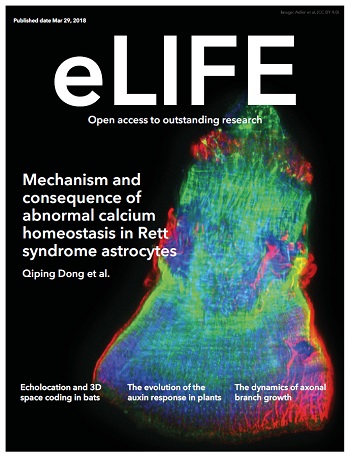蜜蜂嗅觉编码的快速钙动力学分析
IF 6.4
1区 生物学
Q1 BIOLOGY
引用次数: 0
摘要
脊椎动物和无脊椎动物的嗅觉系统在气味处理方面有许多相似之处。特别是昆虫,由于其嗅觉回路的可操作性,已成为嗅觉研究的相关模型。在这里,我们利用快速钙成像技术以高时间分辨率跟踪了蜜蜂触角叶(AL)中投射神经元在嗅觉刺激过程中的活动。我们观察到了反应曲线的异质性和抑制活动的丰富性,这导致了不同的反应潜伏期和刺激特定的气味后神经特征。记录的钙信号被输入到一个蘑菇体(MB)模型中,该模型实现了嗅觉投射神经元、Kenyon 细胞(KC)和 MB 输出神经元(MBON)之间连接的基本特征。该模型解释了与 AL 相比,MB 对气味的辨别能力增强的原因,并揭示了两个不同的 KC 群体的招募情况,它们将气味及其余香作为两个独立但在时间上一致的神经对象。最后,我们发现,KC-MBON突触的学习诱导调节既能解释蜜蜂在不同条件反射方案下联想学习得分的变化,也能解释蜜蜂的反应潜伏期。因此,它提供了一个简单的解释,说明刺激与奖赏之间的时间或然性是如何被编码的,而不需要时间追踪。这项研究拓宽了我们对蜜蜂嗅觉编码和学习的理解。它表明,一个基于简单 MB 连接规则并以真实生理数据为基础的模型可以解释气味处理和联想学习的基本方面。本文章由计算机程序翻译,如有差异,请以英文原文为准。
Analysis of fast calcium dynamics of honey bee olfactory coding
Odour processing exhibits multiple parallels between vertebrate and invertebrate olfactory systems. Insects, in particular, have emerged as relevant models for olfactory studies because of the tractability of their olfactory circuits. Here, we used fast calcium imaging to track the activity of projection neurons in the honey bee antennal lobe (AL) during olfactory stimulation at high temporal resolution. We observed a heterogeneity of response profiles and an abundance of inhibitory activities, resulting in various response latencies and stimulus-specific post-odour neural signatures. Recorded calcium signals were fed to a mushroom body (MB) model constructed implementing the fundamental features of connectivity between olfactory projection neurons, Kenyon cells (KC), and MB output neurons (MBON). The model accounts for the increase of odorant discrimination in the MB compared to the AL and reveals the recruitment of two distinct KC populations that represent odorants and their aftersmell as two separate but temporally coherent neural objects. Finally, we showed that the learning-induced modulation of KC-to-MBON synapses can explain both the variations in associative learning scores across different conditioning protocols used in bees and the bees' response latency. Thus, it provides a simple explanation of how the time contingency between the stimulus and the reward can be encoded without the need for time tracking. This study broadens our understanding of olfactory coding and learning in honey bees. It demonstrates that a model based on simple MB connectivity rules and fed with real physiological data can explain fundamental aspects of odour processing and associative learning.
求助全文
通过发布文献求助,成功后即可免费获取论文全文。
去求助
来源期刊

eLife
BIOLOGY-
CiteScore
12.90
自引率
3.90%
发文量
3122
审稿时长
17 weeks
期刊介绍:
eLife is a distinguished, not-for-profit, peer-reviewed open access scientific journal that specializes in the fields of biomedical and life sciences. eLife is known for its selective publication process, which includes a variety of article types such as:
Research Articles: Detailed reports of original research findings.
Short Reports: Concise presentations of significant findings that do not warrant a full-length research article.
Tools and Resources: Descriptions of new tools, technologies, or resources that facilitate scientific research.
Research Advances: Brief reports on significant scientific advancements that have immediate implications for the field.
Scientific Correspondence: Short communications that comment on or provide additional information related to published articles.
Review Articles: Comprehensive overviews of a specific topic or field within the life sciences.
 求助内容:
求助内容: 应助结果提醒方式:
应助结果提醒方式:


